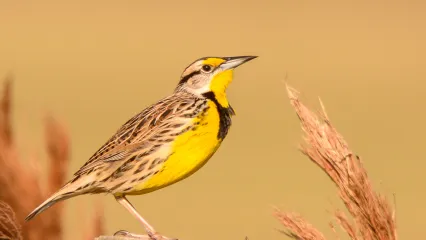
Description
The wood duck (Aix sponsa} is among the most colorful ducks found in Oklahoma. The wood duck is one of the most recognizable waterfowl species in North America. Males have a brightly colored head with the top and crest being an iridescent green. There are white stripes along the cheeks and neck separating the black sides of the head from the shiny green on the top. They have red bills with a yellow patch at the base, along with bright red eyes. Their chest and rump a rich chestnut color. Females are a more drab grayish brown color with a white teardrop female wood duck is unable shape around their eye. Their heads have a crest similar to the males, but not as drastic. The speculum portion of the wing is dark blue with white tips.
Wood ducks have sharp claws. These allow the ducks to perch and nest in trees, abilities not commonly found in North American ducks. Wood ducks are dabblers, meaning they primarily tip upside down in the water to feed rather than diving under to gather food. Their primary food source is plant material, which makes up 80 percent of their diet. They also eat insects, snails and even small fish from time to time.
By the late 1800s, market hunting and habitat loss sent wood duck populations into extreme decline. Many biologists believed the species was heading toward extinction, however, wood duck populations began to recover in the 1920s due to the implementation of The Migratory Bird Treaty Act of1918 and more hunting regulations. The creation of nest boxes in the 1930s also gave the population a boost. About the same time, beaver populations increased, and more beaver dams led to an increase in wetlands, providing more habitat for wood ducks. Today, wood duck numbers are good, and the population is stable or increasing.
Size
Wood ducks are usually about 22 inches long with wingspans of 26 to 29 inches.
Habitat
Wood ducks are cavity nesters, using holes in trees. While cavity nesters are generally safer from predators, their nest sites are more limited. This leads to a problem known as "dump nesting." Dump nesting or nest parasitism is when a female wood duck is unable to locate a nest site of her own, so she lays her eggs on the nest of another female wood duck.
To help reduce the chances of nest parasitism, conservationists employ wood duck boxes as nesting sites. The boxes are about 24 inches tall, 12 inches wide, and 12 inches deep with a 4-inch hole cut in the center. A layer of wood shavings in the bottom of the box provides nesting material for the ducks. The females use the shavings to cover their eggs during the laying process or while taking breaks from incubation to go feed. Nest boxes are easy to build and maintain, and are a great way to get involved in conservation.
Life Cycle
In the wild, the average lifespan of a wood duck is four years, but in some cases they can live more than 20 years. The oldest wood duck recorded was 22 years and 6 months. It was banded in Oregon and found in California.


